
Rajab Waxing (NEW) Crescent Observation Results
So far, the earliest sighting of the crescent -after sunset- was on Thursday 03 July 2008 by Mr. Majid Marzani from Iran, the crescent was also seen on this day from USA and Canada.
Thursday 03 July 2008:
- Indonesia: Not Seen: ICOP member, Mr. AR Sugeng Riyadi said: "Waxing Crescent (New, Evening) for Rajab 1429 AH, was Not Visible Even With Optical Aid; from my location: PPMI Assalaam, Surakarta - INDONESIA (Long: 110:46:14,0, Lat: -07:33:08,0, Ele:111,0, Zone:7,00) -Sunset @ 17:31 LT -Moonset@ 17:49 LT According to the Goverment Calendar (Hisab), the First Rajab 1429 AH will begins in INDONESIA on Friday, 4 July 2008."
- Pakistan:
- Not Seen: ICOP member Mr. Tahir Gul Hasan said: "The Rajab 1429 crescent moon was NOT sighted at Panjgur on the evening of 3 July 2008. Location: 60 nm Northeast of Panjgur (N2737.6/ E6457.5) while flying an Airbus A-310. Sighting altitude: 10,100m AMSL. Observation Time: sunset (20:51 LT) until moonset (20:32 LT). Expected Moon Azimuth: 296 degrees. Expected Moon Altitude: < 2 degrees."
- Not Seen: ICOP member Mr. Muhammad Sultan Alam said: "Tonight the conditions of the moon were very defective in Pakistan and according to the all old and new criteria of moon sighting; there was no possibility at all, of the crescent being sighted with the naked eye in Pakistan. In spite of these facts, to increase the trust of common people upon the Science of Moon-sighting and because the people become confused due to the 29th day according to the Ummul-Qura calendar, I requested many members of the moon-sighting committees of our institute "JAMIA-TUR-RASHEED" and many of my friends all over Pakistan (at least 15 Muslims scholars with many persons) to sight the moon but the moon could not be sighted, as it was expected tonight. Our reporters have tried to sight the crescent moon at these places: (In Sindh) Karachi, at 7 places + Tando Ghulam Ali. (In Sarhad) Charsaddah, Swabi, Hango, Battal, Kohat. (In Punjab) Shorkot, Sheikhupura. (In Baluchistan) Pishin."
- Iran: Seen: ICOP member Mr. Majid Marzani said: "The crescent was seen whit 40*150 and 20*120 binoculars in West Azarbayejan in Iran by Mohammad Fathi - Ehsan Mehrjo - Majid Marzani - Seyed Hadi Tabatabaie."
- Iraq: Not Seen/Hazy: ICOP member Mr. Hassan Alsabbar said: "Diwaniya, Iraq. We used Meade LX90 GPS 10 inchs telescop and 6 inchs telescop and Binocular 8*50 but the Crescent was not seen. The western horizon was some dust and sunset in 07:06 before 4 minut from real time to sunset 07:10 in local time."
- Bahrain: Not Seen/Hazy: ICOP member Mr. A.Hameed Ali Haji said: "The new crescent was not seen. The western horizon was hazy."
- Saudi: Not Seen/Hazy: ICOP member Mr. Saleh Al-Saab said: "The crescent was 7 degrees above horizon ,but it was dusty."
- Kuwait: Not Seen/Hazy: ICOP member Mr. Hussain Khushaish said: "In Kuwait on Thursday 3 July 2008 I could not see the crescent even with 20*60 binocular. The western Horizon was hazy and dusty that the sun disc disappeared more than 25 minutes before its actual setting time. Yet we have claims of sighting the crescent before sunset or at sunset time !!!!!!"
- Algeria: Not Seen/Hazy: ICOP member Mr. Bankih Kacem said: "Arrived at the station 02 minutes after sunset, we try to observe this crescent, the sky was hazy. 04 people were present at the Merkiche station. The Rajab 1429 crescent was not seen."
- Morocco: Not Seen: ICOP member Mr. Othman Fadli mentioned that he was not able to see the crescent by naked eye, and the sky was clear.
- Senegal: Not Seen/Partly Cloudy: ICOP member Mr. Ibrahima Thierno Lo said: "The new crescent was not seen in Dakar today Thurday, July, 3, 2008. The Sky Near The Western Horizon was partly Cloudy."
- Tanzania: Not Seen: ICOP member Mr. Hamza Rijal said: "30 days completed. We failed to sight the moon on Thursday 3rd July, which was 29th of Jamada II. So we completed 30 days and Saturday the 5th July was the first of Rajab."
- Nigeria:
- Not Seen: ICOP member Mr. Muhammed Ya'sin Qamardeen said: "The hilal of Rajaab was not visible here at Abuja despite good sky, however I have not recieved any positive from any of our observers."
- Not Seen: ICOP member Imam Majolagbe Monsuru mentioned that he didn't see the crescent by naked eye and the sky was clear.
- Cloudy: ICOP member Mr. Usman Dukku said: "It was cloudy here in Bauchi; thus we did not attept sighting the crescent."
- Germany:
- Seen: ICOP member Mr. Mohammad Odeh said: "We had a trip to Germany to test the new technology to observe the crescent during daylight time by CCD imaging. We were three; Mr. Martin Elsasser from Germany, Dr. Yasin Mleaky from Saudi and myself. Martin and Yasin observed the waning crescent at the morning of Wednesday 02 July 2008, and they were able to see the crescent during daylight time. As for the the waxing crescent at the morning of Thursday 03 July 2008, the observers were Martin and myself. I arrived at Munich around 07:40 AM local time (UT+2). I went to the hotel to put my luggage, and then I directly called Martin who kindly came with his wife to take me from the hotel to the Public Astronomical Observatory "Volkssternwarte Munchen" where we will do the observation! We arrived there around 10 AM, and we started the observation, Martin did several attempts to capture the crescent. The crescent was first captured at 10:38 UT+2, however, it was not very clear at that time whether this was really the crescent or not, thus another attempt was done at 11:51, and the crescent was clear then. More image processing later on confirmed that the crescent was really first captured at 10:38 UT+2 with the following values:-
Latitude: 48:07:29N
Longitude: 11:35:59E
Elevation: 550m
Time Zone: UT+2
First Visibility at: 10:38 LT
Topocentric Age (At First Visibility): 07 hours and 06 minutes.
Topocentric Elongation (At First Visibility): 04.88 Degrees."
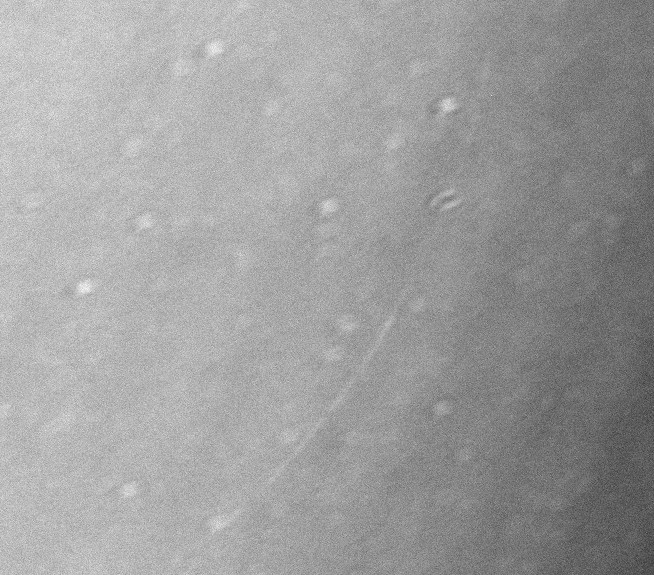
By Martin Elsasser at 11:51
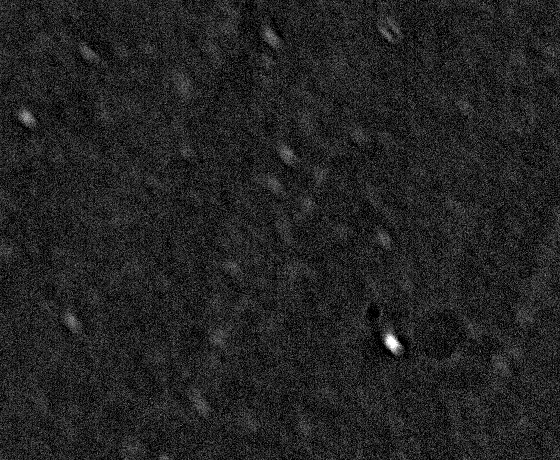
This is a combination of two images taken at 10:38, in which the crescent is clear from its movement between the two images. By Martin Elsasser at 10:38.
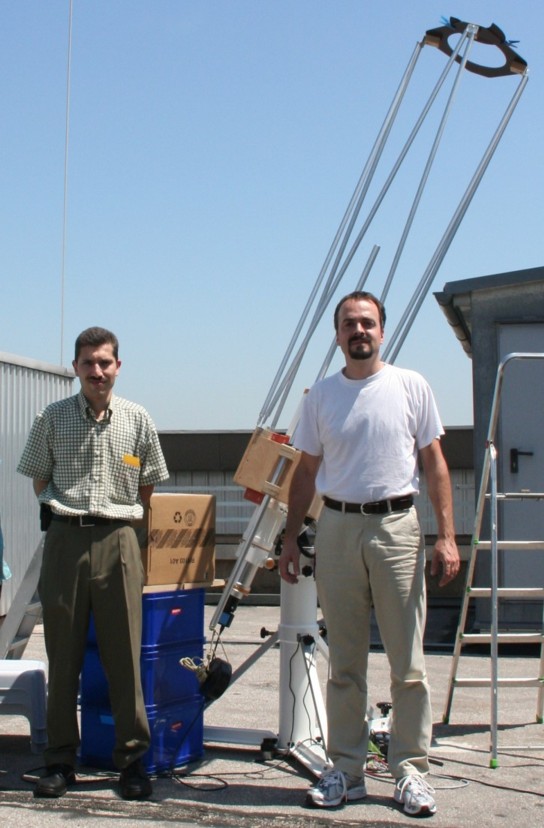
Mohammad Odeh and Martin Elsasser
Notice that the crescent was NOT seen even through telescope! The crescent was ONLY seen using a CCD camera after image processing.
- Cloudy: ICOP memeber Mr. Gerhard Ahmad Kaufmann mentioned that it was totally cloudy.
- UK:
- Not Seen: ICOP member Mr. Qamar Uddin from York said: "I have tried to sight the crescent moon (Hilal) from a very high location in York (UK) after sunset (Magrib) prayers, today 29th Jamada Al-Thani 1429 AH. I was unable to sight it even with optical aids (a Bresser 10 x 50 binocular). The astronomical data for today’s observation are as follows. Time of Observation (York, UK): from 22:00 hrs (BST = GMT + 1 hr), Moon's Azimuth: 308 deg, Moon's Altitude: 2 deg (above horizon), Sun's Altitude: -2 deg (below horizon), Elongation: 10 deg, Sunset: 21:38 hrs, Moonset: 22:24 hrs, Sunset-Moonset (Lag): 00:45 hrs, Moon's Age: 18:41 hrs. My colleagues from York Astronomical Society told me the crescent moon will not be visible today (Thursday, 3 July 2008) due to it being too close to the horizon and the sun. Sighting efforts from London by Shaykh Sulayman Gani and team was also negative (with a clear sky)."
- Not Seen: ICOP member Dr. Muhammad Afifi al-Akiti from Oxford said: "Sighting not attempted. I am travelling today on Thursday the 29th day of Jumada II, and am unable to perform the moonsighting for Rajab. Nevertheless, I received reports of negative sightings in Morocco despite clear skies - a country which the UK could easily rely on - this would mean that the present month of Jumada is to be completed, and consequently, the first day of Rajab there has been announced to be the day after tomorrow, Saturday 5th of July (beginning from Maghrib of the 4th)."
- USA:
- Not Seen: ICOP member Mr. Milad Ali Ershaghi from (Claremont, CA) said: "Local sunset time was 8:06pm and moonset time was 9:05pm. I searched for the new moon from about 8:45pm until 9:00pm in Claremont, California - but alhamdulillah, was not able to find it - due to the presence of smog on the horizon."
- Seen: ICOP member, Mr. Gulamabbas Khakoo from (Newport Beach, CA) said: "Sighted the crescent with my son ZaheedHusein for the month of Rajab here at Balboa Peninsula, Newport Beach, Zip code 92661; California. Local time 8:30pm with naked eye on this Thursday evening of July 3rd, 2008 on left side of Sunset. The top horn was between 12 & 1 O'clock (closer to 12) and bottom horn was between 7 & 8 O'clock closer to 7). Longitude - W117 53' 56" Latitude - N33 36' 6". Weather Condition:
Sunset 8:08pm
Condition 70 deg. F clear
Humid. 78%
Wind from S 5mph
Pressure 29.80in
Visibility 10.0 miles"
- Not Seen/Hazy: ICOP member Mr. Javad Torabinejad from (Blacksburg, VA) said: "This evening (Thursday, July 03, 2008), the western horizon was mostly cloudy and very hazy. Using a pair of 7X50 binocular, I scanned the most likely areas for sighting with no success."
- Canada: Seen: ICOP member Dr. Maher Nofal said: "The crescent was sighted with naked eye on Thursday evening of July 3th 2008. It was seen easily with naked eye."
Friday 04 July 2008:
- Indonesia: Seen: ICOP member Mr. Ma'rufin Sudibyo mentioned that the crescent was seen by binoculars from Kebumen city and Gresik city, and it was seen by naked eye from Rivervale city in wetsern Australia.
- Thailand: Seen: ICOP member Mr. Ali Damsamut said: "The new crescent was seen in Phuket, Thailand today Friday, July, 4, 2008. The Sky was cloudy but I could seen Hilal about 5 minute after sunset 30 minute."
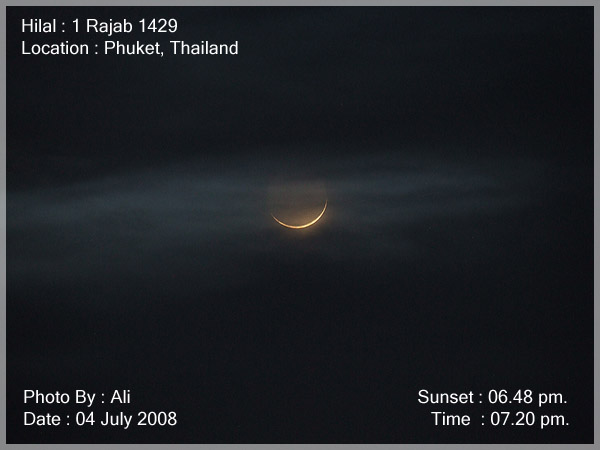
- India: Seen: ICOP member Mr. Mohammad Amin said: "In INDIA many Cities could see the clear Crescent on 4/7/2008. Though in our own City Mangalore the sky was cloudy and we could not locate on our own but we have got conformation from many places of the positive moon sighting. Accordingly in India 1st of Rajab will be on 5th of July Saturday 2008. In Pakistan also crescent was sighted as per TV Reports"
- Bangladesh: Seen: ICOP memeber Mr. ABM Hassan mentioned that he was able to see the crescent by naked eye.
- Pakistan:
- Not Seen/Hazy: ICOP member Mr. Tahir Gul Hasan said: "The Rajab 1429 moon was NOT SIGHTED at Lahore on the evening of 4 July 2008. Location: Lahore (my residence rooftop) Method: visual & binoculars. Weather: thin clouds with dust-haze. Observation Time: sunset (20:13 LT) until 21:10."
- Seen: ICOP member Mr. Muhammad Sultan Alam said: "I requested many members of the moon-sighting committees of our institute "JAMIA-TUR-RASHEED" and many of my friends all over Pakistan to sight the moon. Only a member of personal moon-sighting committees of our institute "JAMIA-TUR-RASHEED", Maulana Abdul-Qahhar with another Aalim easily sighted the moon in Pishin, Baluchistan from 21:08 to 21:40 LT (UT+6). Sunset was at 20:45. Western sky was 20 degrees clear and was partially little cloudy above 20 degrees. Members of the official moon-sighting committee of Pakistan have also sighted the moon in Queta, Baluchistan. Hence, after ending the 29 days of Jumadath-thaniah, Tomorrow July 5, 2008 is 1st Rajab in Pakistan.
Note: Our reporters also tried to sight the crescent moon at the following places but they could not sight due to full cloudy sky: (In Sindh) Karachi, at 5 places, Nooriabad, Hyderabad. (In Sarhad) Charsaddah, Swabi, Abbotabad, Battal, Kohat. (In Punjab) Shorkot, Sheikhupura, Texela."
- Kuwait: Seen: ICOP member Mr. Hussain Khushaish said: "In Kuwait on Friday 4 July 2008 I could see the crescent in the following order first seen with binocular at 18:42, first seen with naked eyes at 18:48, local sunset at 18:52. The western horizon was littel hazy."
- Algeria: Seen: ICOP member Mr. Bankih Kacem said: "The sky was hazy, the western horizon was partly cloudy.
The Rajab 1429 crescent was seen by binoculars at 19:53 LT then by naked eyes at 19:55."
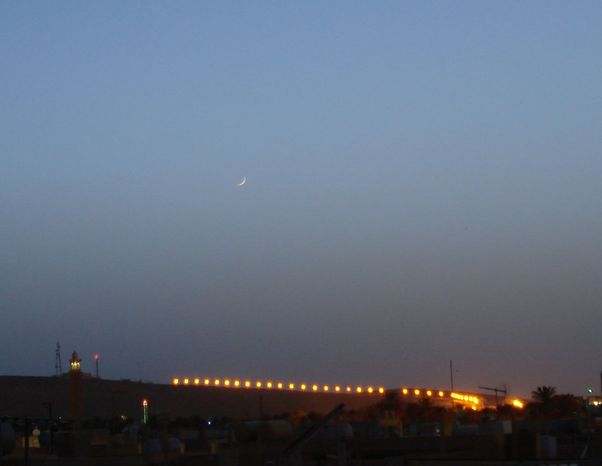
- Nigeria: Seen: ICOP member Imam Majolagbe Monsuru said: "After Solatul Magrib we all sighted the young moon by 7:15pm till 7:50pm."
- South Africa: Not Seen: ICOP member Dr. Abdurrazak Ebrahim said; "Stormy weather in Cape Town. Hilaal sighted from northern areas of South Africa."
- UK:
- Cloudy: ICOP member Dr. Muhammad Afifi al-Akiti from Oxford said: "Not sighted owing to clouds. After a moonsighting seminar with the community of High Wycombe on Friday, the 30th day of Jumada II (4 July 2008), a group of us attempted to sight the expected Rajab hilal immediately after Maghrib prayers. Unfortunately, the western horizon is completely overcast. The numerous reports of positive sightings to the East of UK today, however, confirms that the 1st day of Rajab would be tomorrow, Saturday 5th of July (beginning from today's Maghrib), and that the 27th of Rajab for the UK should fall on Thursday, the 31st of July (beginning from Maghrib of the 30th)."
- Cloudy: ICOP member Mr. Mohammad Baig from London said: "Had it not been for the clouds I am sure the sighting would have been quite easy but the western horizon remained cloudy all evening."
- Hungary: Seen: ICOP member Dr. M. Al-Majari mentioned that he was able to see the crescent by naked eye.

The OFFICIAL First Day in Different Countries
Friday 04 July 2008:
- Indonesia
- Saudi
- UAE
- Kuwait
- Bahrain
- Qatar
- Jordan
- Egypt
- Algeria
Saturday 05 July 2008:
- India
- Pakistan
- Morocco
- Senegal
- Tanzania
- South Africa

When to Observe Jumadal Thani Waning (OLD) Crescent ?
The geocentric conjunction (Geocentric New Moon) will occur Inshalla on (Thursday 03 July 2008) at
02:19 UT.
Sighting the OLD crescent on (Wednesday 02 July 2008) is shown in the below graph using the program Accurate Times by Mohammad Odeh according to Odeh criterion. Where:-
- It is impossible to see the OLD crescent from the areas located under the red color. Because either the Moon on this day rises after the Sunrise and/or the topocentric conjunction occurs before the Sunrise.
- The crescent is expected to be seen by optical aid only from the areas located under the blue color.
- The crescent is expected to be seen by optical aid from the areas located under the magenta color. In these areas the crescent could be seen by naked eye if the atmospheric conditions are superb and the observer is experienced.
- The crescent is expected to be easily visible by naked eye from the areas located under the green color.
- The crescent can not be seen from uncolored areas, even though the Moon rises in these locations before the Sunrise and the topocentric conjunction occurs after the Sunrise, but the Moon is not sufficiently illuminated in order to be seen as crescent even by optical aid.
- Kindly notice that the below graph shows the possibility of seeing the crescent from areas between 60 degrees north of Equator down to 60 degrees south of Equator.
Wednesday 02 July 2008
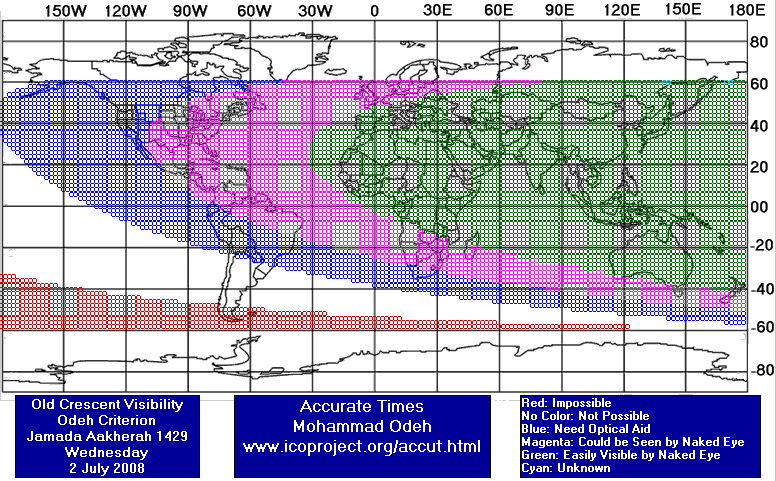

Jumadal Thani Waning (OLD) Crescent Observation Results
Wednesday 02 July 2008:
- Indonesia: Seen: ICOP member, Mr. AR Sugeng Riyadi said: "The Waning (Old) Crescent of Jumadal Tsaniyah 1429 AH, was SEEN from my location: Bendo Ketitang Juwiring Klaten - Central Java Indonesia Longitude = 110°44' E Latitude = 7°41 S Elevation = 98 meters Time Zone = GMT+7 hours Observed: Wednesday, 2008 July 02 Observer: 1. AR Sugeng Riyadi (in Klaten, SEEN) 2. Ahmad Falah (in Jepara, SEEN by naked eye) My Instruments: Naked Eye, Binocular, Canon DSLR Camera, and Nokia9300i-Clock The Crescent was SEEN @ 05:20 (alt= 5°45') - 05:45 LT (alt=11°47'), Az=59°25'. SunSet @ 05:50 LT, Az=67°32'. More about our activities, visit http://blogcasa.wordpress.com/"
- Germany: Seen: ICOP member Mr. Martin Elsaesser said: "This was a joint daytime crescent observation with Dr. Mleaky, using the special daytime imaging technique. The crescent could easily be imaged at an elongation of 9.8° in our first attempt and showed at lot of structure."
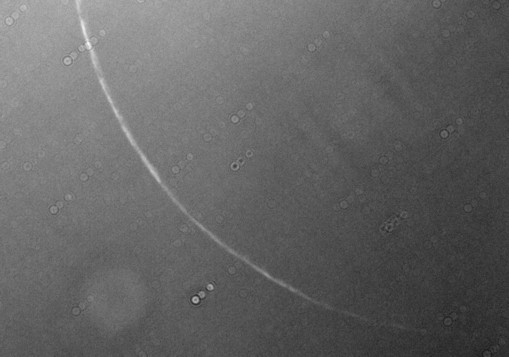
Apart of the above observation which was done at daytime, where the crescent was seen by CCD imaging after image processing, Mr. Martin observed the crescent at twilight using the traditional methods, and he said: " Horizon was fine. The crescent could be easily seen with binoculars and naked eye."


















